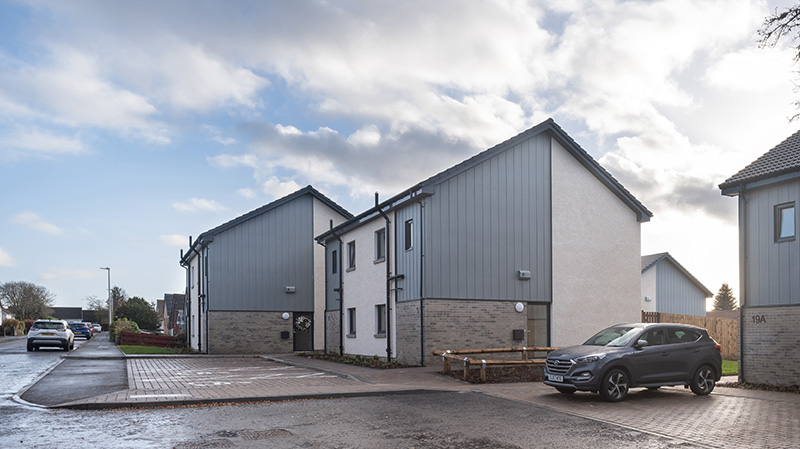
Lizzy Westmacott, associate director/regional head of sustainability at ECD Architects, shares lessons from Scottish Passivhaus social housing schemes
THE Scottish Government has just published the consultation on its proposed Scottish Passivhaus equivalent. ECD Architects is joining the Passivhaus Trust in encouraging the Scottish public and wider construction industry to respond to the consultation to help ensure the policy is ambitious and stays on track.
There will be a steep learning curve for the Scottish construction industry to get itself Passivhaus-ready so it’s great that the Government has set out the need for a transition period to allow for training and industry preparations. As architects and Passivhaus designers, we have worked on a wide range of Passivhaus projects in Scotland, including large-scale social housing developments, such as a 15-unit social housing scheme in Drymen for Hanover Housing Association, a 90-unit project for Midlothian Council in Newbattle, and 15 houses for East Dunbartonshire Council in Twechar.
We are keen to share useful lessons from the projects we’ve worked on to help speed up this transition, as well as give encouragement to the Scottish construction industry that we can do this!
Key tips & lessons
• Working with builders new to Passivhaus: On many of the projects we’re working on the contractor involved is new to Passivhaus construction. A willingness on their part to learn and good early stage discussions across the project team can reap dividends. Good practice on-site includes the appointment of dedicated on-site airtightness champions, regular toolbox talks, key stage design reviews, regular site inspections, and setting up test rigs for the building team to practice on.
• Optimising orientation and form factor: It is worth emphasising the importance of early-stage design and simplicity of form to help keep costs down and help with deliverability. A simple form factor and good orientation can reduce the need for expensive insulation products to meet challenging U-values etc. Design using Passivhaus Planning Package (PHPP) is a key component of this. For example, at our Drymen project a key feature of the design was that the homes’ internal layouts were designed to optimise solar gains. The dwellings use a standard plan layout, which is then flipped as necessary to allow all the living areas to be located on the south facades to benefit from passive solar gains.
• Continual learning: Ongoing communication and discussions between the project team are crucial to problem-solving. After every project, a lessons-learned document is created so that we are continually improving the delivery of Passivhaus projects.
• Using standard building techniques: Many of the Passivhaus social housing projects we work on are built using standard Scottish timber frame kit construction, which helps improve quality, minimises on-site construction time, and reduces the need for additional materials. Working with familiar building methods can also help first-time Passivhaus builders. Passivhaus doesn’t need to be complicated! It just requires a shift in mindset and approach.
ECD promotes the Passivhaus Standard because it provides better quality, more comfortable buildings that minimise energy use and close the gap between ‘as designed’ and ‘as built’ performance. Evidence and feedback to date show that Passivhaus buildings perform as predicted. This is an important achievement given the discrepancy between design aspiration and as-built performance of many new buildings in the UK can be as much as 50-100% (the ‘performance gap’).
Our project at Drymen was one of the first certified Passivhaus social housing projects in Scotland. It was a mixture of housing for over-55s and general needs housing. The bungalows for older people replaced post-war housing that only had 10mm insulation, so the residents who have returned to the new housing have seen huge benefits in terms of well-being, comfort, low energy costs, and energy security.
Passivhaus design is challenging. And it involves upskilling our industry’s workforce. But that doesn’t mean that we shouldn’t do it, or that it isn’t worth it. We shouldn’t be settling for the bare minimum. We should be pushing ourselves to be better now, so that we reap the benefits as a country in years to come.
Our experience demonstrates that Scotland can rise to the challenge of a Scottish Passivhaus equivalent. If, as an industry, we can expand this around the country, we will have a significant, positive impact on people’s lives, their fuel bills, and our journey to net zero. This is such an exciting opportunity for Scotland to build the homes we deserve – homes that actually perform as intended. The industry has shown that we can do this, the climate crisis dictates that we need to, so let’s do it!
• The Scottish Government consultation on the Scottish Passivhaus equivalent is open until Wednesday 23 October 2024.











